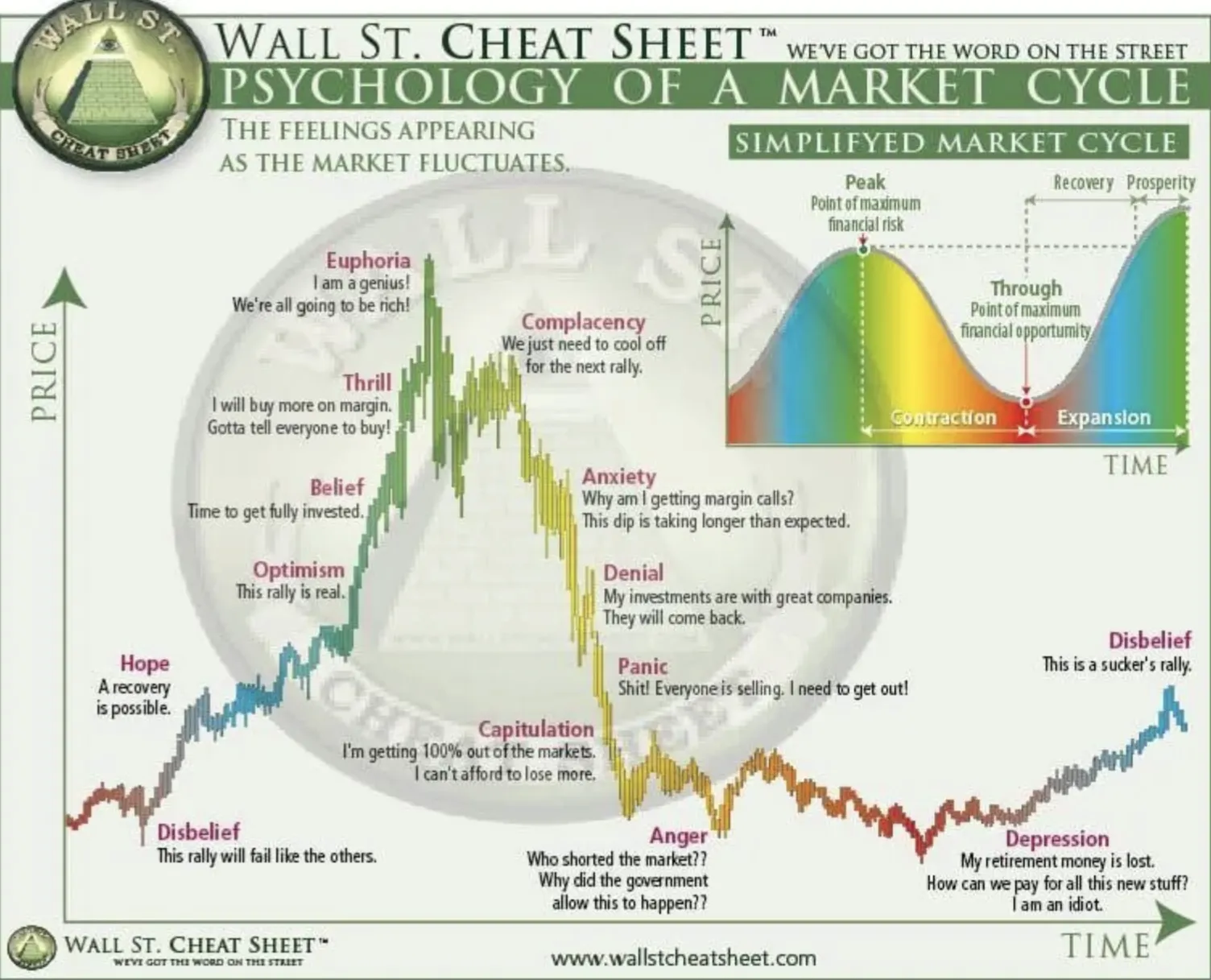On average, a cryptocurrency bear market lasts about a year, sometimes up to two years. This phase occurs when supply exceeds demand, causing prices to decline over an extended period of time.
One of the most severe bear markets occurred in 2022. During this period, FTX, one of the largest cryptocurrency exchanges by trading volume, collapsed following a massive bank run. This drop triggered a ripple effect, leading to the collapse of several hedge funds and lending protocols, marking a significant low point for the sector.
Bear Market Psychology Explained
Recently, there has been talk of the cryptocurrency market returning to a bearish phase. Many cryptocurrencies have struggled since Bitcoin (BTC) hit $73,750 in March. This decline has raised fears that the market is entering another long period of price decline.
The event, which surprisingly happened before the halving, sent shockwaves through the market. At the time, many believed that cryptocurrency prices would reach even higher heights.
But that’s not the case. Instead, the price of BTC, like that of other cryptocurrencies, has been either consolidating, falling, or involved in false breakouts.
These factors, among others, have led some participants to suggest that the market could be entering a bearish phase. To assess this possibility, BeInCrypto looks at the Market Cycle Psychology chart for insights.
Learn more: How to Make Money in a Bear Market

As you can see above, this chart shows 14 different stages. For example, disbelief marks the end of the bear market as cryptos start to transition to the bullish phase. There are also phases of excitement, anxiety, euphoria, or complacency.
Judging by appearances, the disbelief phase occurred around the first quarter of 2023.when the price of Bitcoin started to see steady gains. In the meantime, the “thrill” period probably occurred during the ETF approval earlier in January this year, as people were urged to step up their efforts to buy BTC.
The euphoria likely occurred between March, when BTC and many other altcoins and meme coins reached different highs. The cooling of recent times may suggest that this cycle is somewhere between complacency and anxiety, which usually precedes a bear market.
Bitcoin Holders Say Big No To Slowdown Despite ETH Problems
However, periods of complacency and anxiety may have been false alarms. According to Glassnode, the sell-side risk ratio of long-term Bitcoin holders offers a clue. This metric measures the level of profit-taking compared to past market cycles.
Currently, the ratio remains below the peak seen during the 2021 bull market, indicating that long-term Bitcoin holders are refraining from selling.

Actions like these suggest strong conviction among long-term holders. In this regard, the on-chain analytics platform explains that:
“A high percentage of the Bitcoin network’s wealth is held by this cohort of investors compared to previous cycle ATH breaks, suggesting that there is a degree of investor patience and they are waiting for higher prices.”
If this is confirmed, the bear market may not be imminent and the cycle could still be in its bearish phase. However, some market participants remain skeptical due to the underperformance of some altcoins, especially Ethereum (ETH).
In 2021, after Bitcoin hit its all-time high (ATH), ETH quickly followed suit and surpassed its previous high. This time, however, the situation is different, even with the launch of Ethereum spot ETFs.
Currently, ETH is trading at $2,657, down 45% from its ATH. Previously, many market participants confidently predicted that the altcoin would reach between $8,000 and $10,000, but these expectations have yet to materialize.

Some of these optimistic predictions have faded as ETH continues to underperform, reinforcing the belief that a bear market is coming. However, it is important to recognize that major cryptocurrencies, including BTC and ETH, have recently experienced a period of distribution, which has contributed to the recent price correction.
Bears Still Waiting for a Crypto Winter
Market participants might also be concerned that crypto whales have slowed down their BTC purchases. However, such pauses are typical during a bull cycle. Despite this, caution is warranted, as indicated by the net unrealized profit/loss (NUPL).
The NUPL measures whether investors are making a profit or a loss. When the value increases, it indicates that more investors are making higher profits. Conversely, a decrease signals a decline in profits.
This metric also helps determine whether the market has entered a bear market. An increase indicates a stronger bull market, while a significant decrease increases the likelihood of a bear market.
Read more: Bitcoin Halving History: Everything You Need to Know

At press time, Bitcoin’s NUPL sits at 0.46. In July, a similar drop in this range led BTC price to drop to $55,857. The last time the indicator reached this level, Bitcoin price fell to $42,576.
This makes the current reading a critical point for the market. If NUPL continues to decline and reaches 0.40 or lower, bears could take control. According to Grizzly, a pseudonymous analyst on CryptoQuant, if this happens, BTC could potentially drop to $40,000.
“If the index continues its downward movement, it is reasonable to think that the bears could take complete control of the market. In such a scenario, the price could drop to around $40,000,” Grizzly wrote in his analysis.
Disclaimer
In accordance with the Trust Project guidelines, this price analysis article is provided for informational purposes only and should not be considered financial or investment advice. BeInCrypto is committed to providing accurate and unbiased reporting, but market conditions are subject to change without notice. Always conduct your own research and consult a professional before making any financial decisions. Please note that our Terms and Conditions, Privacy Policy and Disclaimers have been updated.




